Zheng Ma
Towards Effective Open-set Graph Class-incremental Learning
Jul 23, 2025Abstract:Graph class-incremental learning (GCIL) allows graph neural networks (GNNs) to adapt to evolving graph analytical tasks by incrementally learning new class knowledge while retaining knowledge of old classes. Existing GCIL methods primarily focus on a closed-set assumption, where all test samples are presumed to belong to previously known classes. Such an assumption restricts their applicability in real-world scenarios, where unknown classes naturally emerge during inference, and are absent during training. In this paper, we explore a more challenging open-set graph class-incremental learning scenario with two intertwined challenges: catastrophic forgetting of old classes, which impairs the detection of unknown classes, and inadequate open-set recognition, which destabilizes the retention of learned knowledge. To address the above problems, a novel OGCIL framework is proposed, which utilizes pseudo-sample embedding generation to effectively mitigate catastrophic forgetting and enable robust detection of unknown classes. To be specific, a prototypical conditional variational autoencoder is designed to synthesize node embeddings for old classes, enabling knowledge replay without storing raw graph data. To handle unknown classes, we employ a mixing-based strategy to generate out-of-distribution (OOD) samples from pseudo in-distribution and current node embeddings. A novel prototypical hypersphere classification loss is further proposed, which anchors in-distribution embeddings to their respective class prototypes, while repelling OOD embeddings away. Instead of assigning all unknown samples into one cluster, our proposed objective function explicitly models them as outliers through prototype-aware rejection regions, ensuring a robust open-set recognition. Extensive experiments on five benchmarks demonstrate the effectiveness of OGCIL over existing GCIL and open-set GNN methods.
Cognitive-Radio Functionality: A Novel Configuration for STAR-RIS assisted RSMA Networks
May 30, 2025Abstract:Cognitive radio rate-splitting multiple access (CR-RSMA) has emerged as a promising multiple access framework that can efficiently manage interference and adapt dynamically to heterogeneous quality-of-service (QoS) requirements. To effectively support such demanding access schemes, programmable wireless environments have attracted considerable attention, especially through simultaneously transmitting and reflecting reconfigurable intelligent surfaces (STAR-RISs), which can enable full-space control of signal propagation in asymmetric user deployments. In this paper, we propose the cognitive radio (CR) functionality for STAR-RIS-assisted CR-RSMA systems, leveraging the unique capability of the STAR-RIS to combine element and power splitting for adaptive control of transmission and reflection in CR scenarios. Specifically, the proposed CR functionality partitions the STAR-RIS into two regions independently controlling the transmission and reflection of signals, simultaneously ensuring the required QoS for the primary user and enhancing the performance of the secondary user. To accurately characterize the system performance, we derive analytical expressions for the ergodic rate of the secondary user and the outage rate of the primary user under Nakagami-m fading. Finally, simulation results show that the proposed approach effectively manages interference, guarantees the QoS of the primary user, and significantly improves the throughput of the secondary user, highlighting STAR-RIS as an efficient solution for CR-RSMA-based services.
DeepRTE: Pre-trained Attention-based Neural Network for Radiative Tranfer
May 29, 2025Abstract:In this study, we propose a novel neural network approach, termed DeepRTE, to address the steady-state Radiative Transfer Equation (RTE). The RTE is a differential-integral equation that governs the propagation of radiation through a participating medium, with applications spanning diverse domains such as neutron transport, atmospheric radiative transfer, heat transfer, and optical imaging. Our proposed DeepRTE framework leverages pre-trained attention-based neural networks to solve the RTE with high accuracy and computational efficiency. The efficacy of the proposed approach is substantiated through comprehensive numerical experiments.
Extract, Match, and Score: An Evaluation Paradigm for Long Question-context-answer Triplets in Financial Analysis
Mar 20, 2025Abstract:The rapid advancement of large language models (LLMs) has sparked widespread adoption across diverse applications, making robust evaluation frameworks crucial for assessing their performance. While conventional evaluation metrics remain applicable for shorter texts, their efficacy diminishes when evaluating the quality of long-form answers. This limitation is particularly critical in real-world scenarios involving extended questions, extensive context, and long-form answers, such as financial analysis or regulatory compliance. In this paper, we use a practical financial use case to illustrate applications that handle "long question-context-answer triplets". We construct a real-world financial dataset comprising long triplets and demonstrate the inadequacies of traditional metrics. To address this, we propose an effective Extract, Match, and Score (EMS) evaluation approach tailored to the complexities of long-form LLMs' outputs, providing practitioners with a reliable methodology for assessing LLMs' performance in complex real-world scenarios.
Exploring the Reliability of Self-explanation and its Relationship with Classification in Language Model-driven Financial Analysis
Mar 20, 2025Abstract:Language models (LMs) have exhibited exceptional versatility in reasoning and in-depth financial analysis through their proprietary information processing capabilities. Previous research focused on evaluating classification performance while often overlooking explainability or pre-conceived that refined explanation corresponds to higher classification accuracy. Using a public dataset in finance domain, we quantitatively evaluated self-explanations by LMs, focusing on their factuality and causality. We identified the statistically significant relationship between the accuracy of classifications and the factuality or causality of self-explanations. Our study built an empirical foundation for approximating classification confidence through self-explanations and for optimizing classification via proprietary reasoning.
CapArena: Benchmarking and Analyzing Detailed Image Captioning in the LLM Era
Mar 16, 2025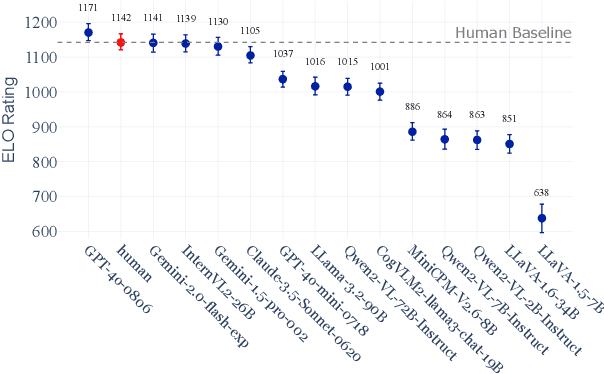
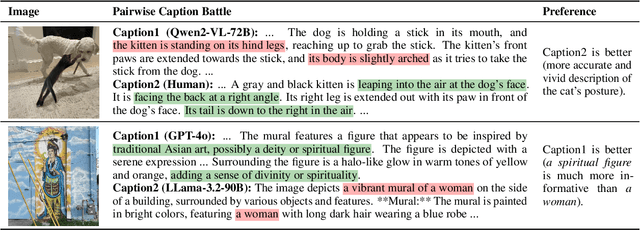
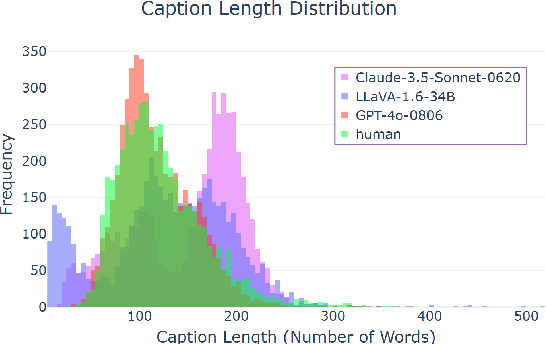
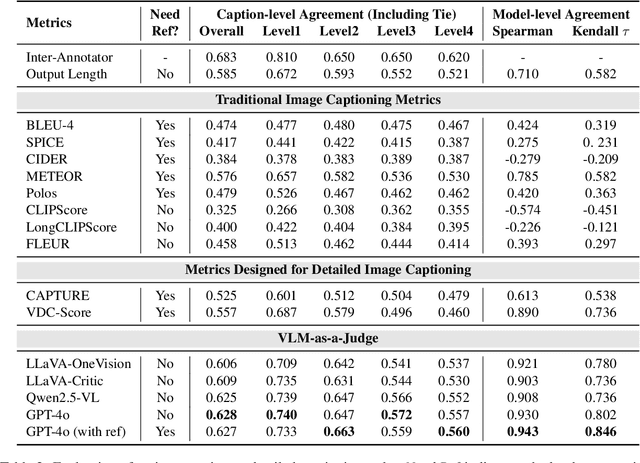
Abstract:Image captioning has been a longstanding challenge in vision-language research. With the rise of LLMs, modern Vision-Language Models (VLMs) generate detailed and comprehensive image descriptions. However, benchmarking the quality of such captions remains unresolved. This paper addresses two key questions: (1) How well do current VLMs actually perform on image captioning, particularly compared to humans? We built CapArena, a platform with over 6000 pairwise caption battles and high-quality human preference votes. Our arena-style evaluation marks a milestone, showing that leading models like GPT-4o achieve or even surpass human performance, while most open-source models lag behind. (2) Can automated metrics reliably assess detailed caption quality? Using human annotations from CapArena, we evaluate traditional and recent captioning metrics, as well as VLM-as-a-Judge. Our analysis reveals that while some metrics (e.g., METEOR) show decent caption-level agreement with humans, their systematic biases lead to inconsistencies in model ranking. In contrast, VLM-as-a-Judge demonstrates robust discernment at both the caption and model levels. Building on these insights, we release CapArena-Auto, an accurate and efficient automated benchmark for detailed captioning, achieving 94.3% correlation with human rankings at just $4 per test. Data and resources will be open-sourced at https://caparena.github.io.
Semi-supervised Anomaly Detection with Extremely Limited Labels in Dynamic Graphs
Jan 25, 2025Abstract:Semi-supervised graph anomaly detection (GAD) has recently received increasing attention, which aims to distinguish anomalous patterns from graphs under the guidance of a moderate amount of labeled data and a large volume of unlabeled data. Although these proposed semi-supervised GAD methods have achieved great success, their superior performance will be seriously degraded when the provided labels are extremely limited due to some unpredictable factors. Besides, the existing methods primarily focus on anomaly detection in static graphs, and little effort was paid to consider the continuous evolution characteristic of graphs over time (dynamic graphs). To address these challenges, we propose a novel GAD framework (EL$^{2}$-DGAD) to tackle anomaly detection problem in dynamic graphs with extremely limited labels. Specifically, a transformer-based graph encoder model is designed to more effectively preserve evolving graph structures beyond the local neighborhood. Then, we incorporate an ego-context hypersphere classification loss to classify temporal interactions according to their structure and temporal neighborhoods while ensuring the normal samples are mapped compactly against anomalous data. Finally, the above loss is further augmented with an ego-context contrasting module which utilizes unlabeled data to enhance model generalization. Extensive experiments on four datasets and three label rates demonstrate the effectiveness of the proposed method in comparison to the existing GAD methods.
Disentangling the Complex Multiplexed DIA Spectra in De Novo Peptide Sequencing
Nov 24, 2024Abstract:Data-Independent Acquisition (DIA) was introduced to improve sensitivity to cover all peptides in a range rather than only sampling high-intensity peaks as in Data-Dependent Acquisition (DDA) mass spectrometry. However, it is not very clear how useful DIA data is for de novo peptide sequencing as the DIA data are marred with coeluted peptides, high noises, and varying data quality. We present a new deep learning method DIANovo, and address each of these difficulties, and improves the previous established system DeepNovo-DIA by from 25% to 81%, averaging 48%, for amino acid recall, and by from 27% to 89%, averaging 57%, for peptide recall, by equipping the model with a deeper understanding of coeluted DIA spectra. This paper also provides criteria about when DIA data could be used for de novo peptide sequencing and when not to by providing a comparison between DDA and DIA, in both de novo and database search mode. We find that while DIA excels with narrow isolation windows on older-generation instruments, it loses its advantage with wider windows. However, with Orbitrap Astral, DIA consistently outperforms DDA due to narrow window mode enabled. We also provide a theoretical explanation of this phenomenon, emphasizing the critical role of the signal-to-noise profile in the successful application of de novo sequencing.
Towards Cross-domain Few-shot Graph Anomaly Detection
Oct 11, 2024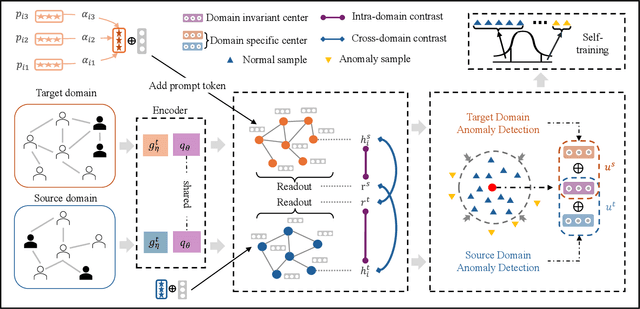
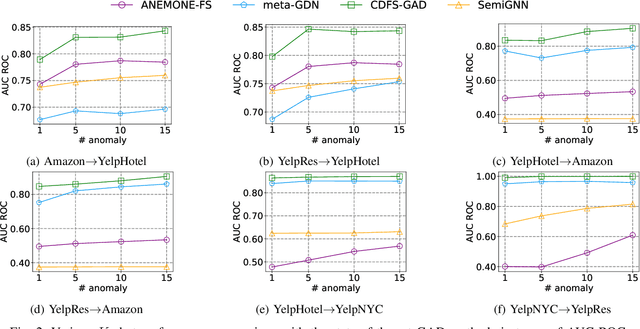

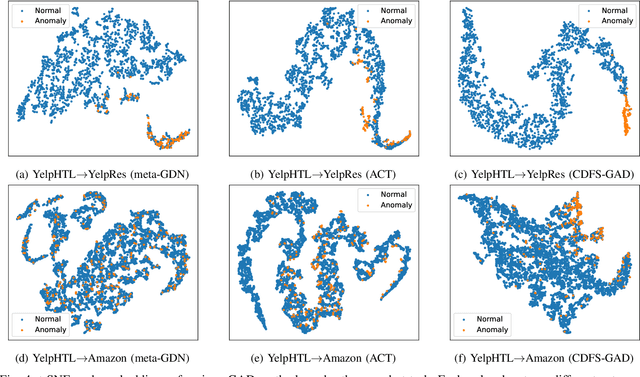
Abstract:Few-shot graph anomaly detection (GAD) has recently garnered increasing attention, which aims to discern anomalous patterns among abundant unlabeled test nodes under the guidance of a limited number of labeled training nodes. Existing few-shot GAD approaches typically adopt meta-training methods trained on richly labeled auxiliary networks to facilitate rapid adaptation to target networks that possess sparse labels. However, these proposed methods often assume that the auxiliary and target networks exist in the same data distributions-an assumption rarely holds in practical settings. This paper explores a more prevalent and complex scenario of cross-domain few-shot GAD, where the goal is to identify anomalies within sparsely labeled target graphs using auxiliary graphs from a related, yet distinct domain. The challenge here is nontrivial owing to inherent data distribution discrepancies between the source and target domains, compounded by the uncertainties of sparse labeling in the target domain. In this paper, we propose a simple and effective framework, termed CDFS-GAD, specifically designed to tackle the aforementioned challenges. CDFS-GAD first introduces a domain-adaptive graph contrastive learning module, which is aimed at enhancing cross-domain feature alignment. Then, a prompt tuning module is further designed to extract domain-specific features tailored to each domain. Moreover, a domain-adaptive hypersphere classification loss is proposed to enhance the discrimination between normal and anomalous instances under minimal supervision, utilizing domain-sensitive norms. Lastly, a self-training strategy is introduced to further refine the predicted scores, enhancing its reliability in few-shot settings. Extensive experiments on twelve real-world cross-domain data pairs demonstrate the effectiveness of the proposed CDFS-GAD framework in comparison to various existing GAD methods.
How Far Are We to GPT-4V? Closing the Gap to Commercial Multimodal Models with Open-Source Suites
Apr 29, 2024



Abstract:In this report, we introduce InternVL 1.5, an open-source multimodal large language model (MLLM) to bridge the capability gap between open-source and proprietary commercial models in multimodal understanding. We introduce three simple improvements: (1) Strong Vision Encoder: we explored a continuous learning strategy for the large-scale vision foundation model -- InternViT-6B, boosting its visual understanding capabilities, and making it can be transferred and reused in different LLMs. (2) Dynamic High-Resolution: we divide images into tiles ranging from 1 to 40 of 448$\times$448 pixels according to the aspect ratio and resolution of the input images, which supports up to 4K resolution input. (3) High-Quality Bilingual Dataset: we carefully collected a high-quality bilingual dataset that covers common scenes, document images, and annotated them with English and Chinese question-answer pairs, significantly enhancing performance in OCR- and Chinese-related tasks. We evaluate InternVL 1.5 through a series of benchmarks and comparative studies. Compared to both open-source and proprietary models, InternVL 1.5 shows competitive performance, achieving state-of-the-art results in 8 of 18 benchmarks. Code has been released at https://github.com/OpenGVLab/InternVL.
 Add to Chrome
Add to Chrome Add to Firefox
Add to Firefox Add to Edge
Add to Edge